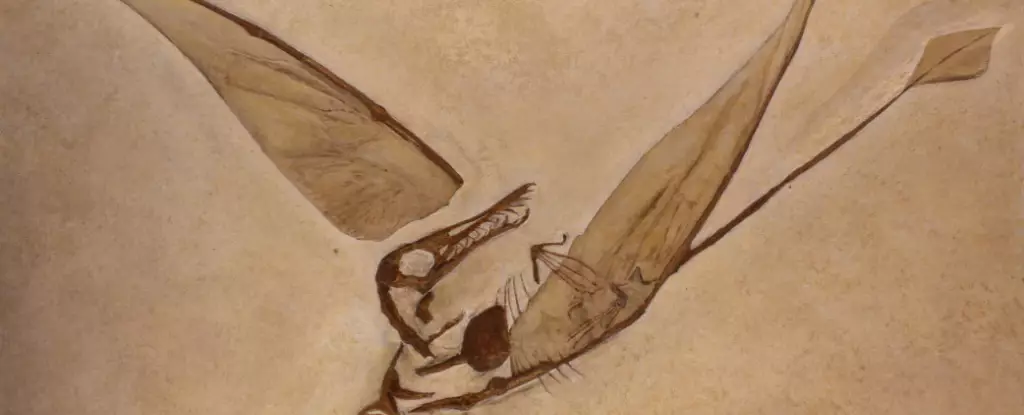Pterosaurs, an extraordinary group of flying reptiles, took to the skies long before birds and bats graced the earth. For decades, scientists have puzzled over the unique adaptations that enabled these creatures to achieve powered flight around 215 million years ago. Contrary to popular belief, their success in aviation wasn’t merely attributed to feathers or hollow bones. Recent research sheds new light on an essential structural characteristic—the stiffness of their tail vanes—which played a crucial role in their aerial prowess.
Pterosaurs represent a fascinating aspect of evolutionary history. They were the first vertebrates to master powered flight, soaring through the air long before birds evolved. While initially small in stature, they eventually included some of the largest flying animals to ever roam the planet. Unlike birds and bats, pterosaurs shared a close evolutionary relationship with dinosaurs, emerging from a different lineage of reptiles that branched off from rabbit-like ancestors. This divergent evolutionary path has raised questions about what specific adaptations allowed pterosaurs to dominate the skies.
Historically, researchers have struggled to identify the unique features that gave pterosaurs their edge in flight. Recent preliminary studies propose that the tail vane—broad and diamond-shaped—provided crucial aerodynamic stability rather than merely serving as a rudder for steering. This notion is particularly intriguing given that many of the characteristics that enabled pterosaur flight, such as the stiffness of the tail, became obsolete in later species and are absent in modern flying animals.
Pterosaur fossils are rarely found intact due to their delicate, hollow bones, which succumb to time’s degradation far more readily than denser materials like mammalian bones. This rarity makes the study of pterosaurs particularly challenging. However, an exciting recent discovery involved four exceptional specimens that retained details of soft tissue. A team of scientists from the University of Edinburgh, led by paleontologist Natalia Jagielska, meticulously examined over 100 pterosaur fossils from various museum collections and identified these specimens under ultraviolet light, which revealed preserved soft tissue structures.
Employing a cutting-edge imaging technique known as laser-stimulated fluorescence, researchers uncovered intricate details hidden within the tail vanes. The analysis revealed robust, vertical rods radiating from the center of the tail bone, connected by thin fibers to form a cross-linked lattice structure. This surprising design not only kept the tail vane rigid but significantly reduced air resistance, allowing for smoother flight maneuvers.
In uncovering the anatomy of the tail vanes, researchers have proposed that this unique structure may have originated from a single contiguous design rather than a composite of scales or feather-like materials. This discovery opens up new avenues for understanding pterosaur evolutionary biology, potentially leading to insights about how flight adaptations emerged in these remarkable creatures over millions of years.
The research also hinted at features commonly associated with aquatic animals, suggesting that pterosaur tail vanes shared similarities with cetacean flukes, which enhance the swimming capabilities of whales and dolphins. Such comparative anatomy enriches our understanding of how different pressures in diverse environments can lead to the evolution of analogous structures across species.
While the stiffness of the tail vane is a critical factor in pterosaur flight, other anatomical features also contributed significantly. Notably, the propatagium, a tendon stretching along the front edge of the wings, was instrumental during take-off and landing. This unique structure, which connects the wrist and shoulder joints of the pterosaur, allowed for nuanced control over airflow, further enhancing their flight capabilities.
Interestingly, modern birds and bats also possess a propatagium, highlighting an essential evolutionary trait that underscores the similarities among avian and pterosaur flight mechanics. Although the design and functionality have diversified, the fundamental purpose remains a testament to the shared lineage of these airborne creatures.
The study of pterosaurs offers a glimpse into the incredible adaptations that facilitated their dominion of the skies during the Mesozoic era. The recent discoveries regarding tail vane structure challenge our earlier assumptions and emphasize the complexity of evolutionary traits that have emerged over millions of years. Through ongoing research, we inch closer to unraveling the intricate tapestry of life that existed alongside dinosaurs, further enriching our understanding of avian evolution and the remarkable innovations that nature has crafted in the pursuit of flight.


Leave a Reply